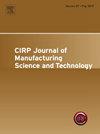Assessing sine and Gaussian fitting for surface feature extraction in real-time wear monitoring of turning operations
IF 5.4
2区 工程技术
Q2 ENGINEERING, MANUFACTURING
CIRP Journal of Manufacturing Science and Technology
Pub Date : 2025-06-09
DOI:10.1016/j.cirpj.2025.05.005
引用次数: 0
Abstract
Due to the challenges in tool condition monitoring, sensor fusion systems and the search for supportive features have gained increasing attention. With advancements in image acquisition and processing, surface image features offer a low-cost, supplementary data source for monitoring applications. This study introduces two novel image features derived from the fitting error metrics of sine and Gaussian functions, applied to column projections of surface images. Unlike conventional texture analysis methods, this approach specifically targets the wave-like patterns characteristic of turned surfaces, enabling localized assessment of surface anomalies. Experiments were conducted with varying cutting speeds, feed rates, and depths of cut to investigate the correlation between the proposed features and tool wear. Static analysis yielded adjusted values of 0.497 for sine fitting and 0.579 for Gaussian fitting, while dynamic analysis demonstrated higher correlations with adj. values of 0.8007 and 0.8197, respectively. Additionally, a cropping analysis was implemented to address potential image acquisition challenges in real-world applications, such as optical distortions and debris interference. Results indicated that focusing on central regions improved static fitting accuracy by up to 28% and dynamic fitting accuracy by up to 16%, underscoring the robustness and practical applicability of the proposed features for localized wear analysis.
评估正弦和高斯拟合在车削作业磨损实时监测中的表面特征提取
由于工具状态监测面临的挑战,传感器融合系统和寻找支持功能受到越来越多的关注。随着图像采集和处理技术的进步,表面图像特征为监测应用提供了一种低成本的补充数据源。本研究引入了两个新的图像特征,这些特征来源于正弦函数和高斯函数的拟合误差度量,并应用于表面图像的柱投影。与传统的纹理分析方法不同,该方法专门针对旋转表面的波浪状图案特征,从而能够对表面异常进行局部评估。在不同的切削速度、进给量和切削深度下进行了实验,以研究所提出的特征与刀具磨损之间的相关性。静态分析结果显示,正弦拟合调整后的R2值为0.497,高斯拟合调整后的R2值为0.579,动态分析结果显示,与相对值的相关性较高,R2值分别为0.8007和0.8197。此外,还实施了裁剪分析,以解决现实应用中潜在的图像采集挑战,如光学畸变和碎片干扰。结果表明,集中在中心区域可将静态拟合精度提高28%,动态拟合精度提高16%,强调了所提出的局部磨损分析特征的鲁棒性和实用性。
本文章由计算机程序翻译,如有差异,请以英文原文为准。
求助全文
约1分钟内获得全文
求助全文
来源期刊

CIRP Journal of Manufacturing Science and Technology
Engineering-Industrial and Manufacturing Engineering
CiteScore
9.10
自引率
6.20%
发文量
166
审稿时长
63 days
期刊介绍:
The CIRP Journal of Manufacturing Science and Technology (CIRP-JMST) publishes fundamental papers on manufacturing processes, production equipment and automation, product design, manufacturing systems and production organisations up to the level of the production networks, including all the related technical, human and economic factors. Preference is given to contributions describing research results whose feasibility has been demonstrated either in a laboratory or in the industrial praxis. Case studies and review papers on specific issues in manufacturing science and technology are equally encouraged.
 求助内容:
求助内容: 应助结果提醒方式:
应助结果提醒方式:


